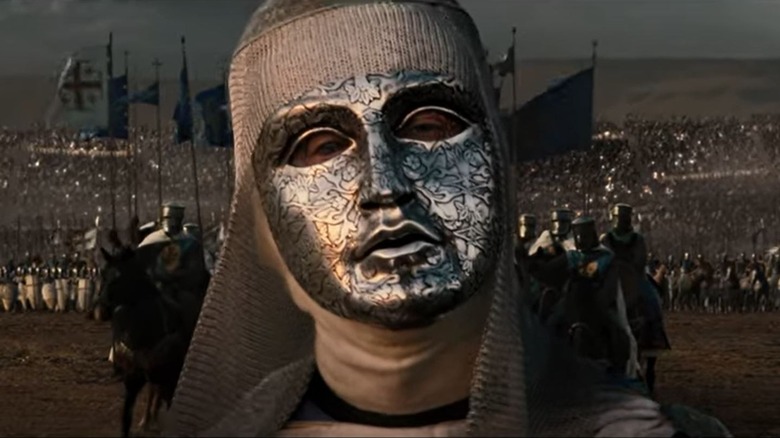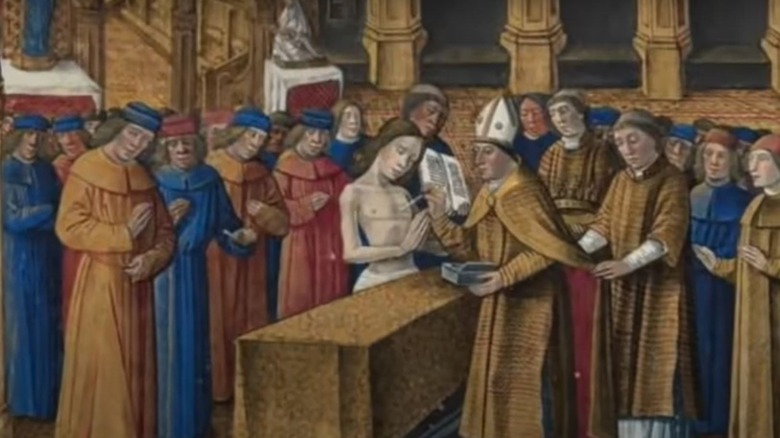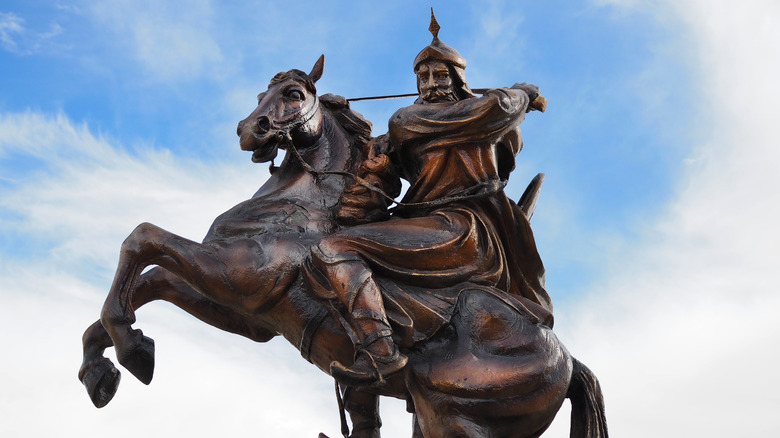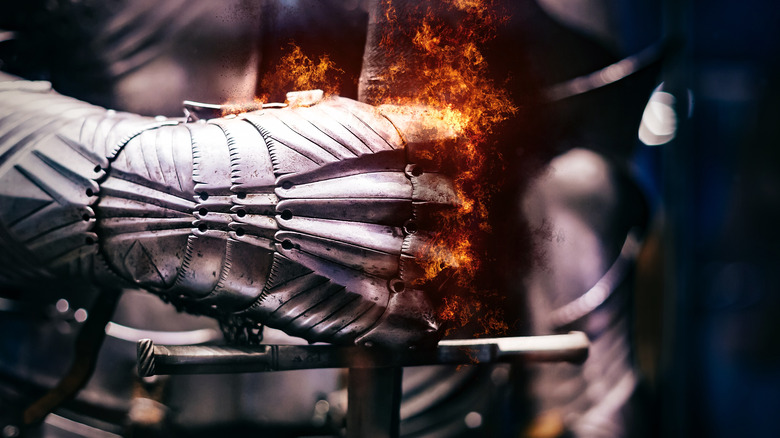Who Was Baldwin IV, The 'Leper King' Of Jerusalem?
It's easy to romanticize and admire a doomed hero. Facing off against enemy hordes and an almost certain death, if only to achieve some noble, self-sacrificial end? Or facing off against an enemy within — some affliction of the body — with no chance of escape? Or in the case of Baldwin IV, the "leper king" of Jerusalem for a mere 11 years, from 1174 to 1185 CE: both.
Baldwin IV indeed had leprosy, an ancient disease going back at least 4,000 years to the Indian subcontinent (via Britannica) and brought to Europe via the travels of Alexander the Great (via News Medical). It's caused by a slow-growing bacteria in the nerves, skin, eyes, and nose that eats away at the body. While once absolutely fatal, it can now be treated (via the CDC). By the time of Baldwin's reign, around 1200 CE, there were over 19,000 hospitals throughout Europe devoted to the disease.
And yet, Baldwin IV wasn't defined by his corrosive illness. While leprosy left most ostracized and helpless, Baldwin IV made a permanent mark on history. He was crowned king as a teenager, and became the nemesis of Saladin, the legendary Muslim sultan who ruled Egypt and fought European Christian crusaders for years (via Britannica). During battle, Baldwin IV stayed on the front lines and held on to his reigns with one hand because he couldn't use the other (via All That's Interesting). And far beyond his title of "leper king," his legacy remains.
The People's Crusade and the Kingdom of Jerusalem
The decades leading up to Baldwin IV's birth and reign were marked by one of the more memorable, conflict-ridden series of events in medieval history: the crusades. The crusades started in 1095 at the Council at Clairemont when Pope Urban II called for people of all classes to march on the Holy Land and take Jerusalem from the Seljuk Turks, as History outlines. The Turks, who were Muslim, had barred Christian pilgrims access to their mutual holy city. Additionally, Byzantine Emperor Alexius I asked Urban to help him shore up against the Turks, whom Alexius was afraid would move on the Byzantine capitol, Constantinople.
Urban's rousing speech provoked a bigger response that anyone anticipated. Some 60,000 to 100,000 people, largely French and German peasants mixed with the odd noble and middle class merchant, showed up for what was later dubbed the "People's Crusade." Not all motivations were pious, of course — protection of land and wealth occupied the minds of many involved. Shockingly, though, these largely untrained combatants not only pushed all the way to Jerusalem, but after being reduced to a mere 1,200 cavalry and 12,000 foot soldiers, besieged the city and won in 1099 (via History). That same year, the Kingdom of Jerusalem was created.
From then until 1291, Christians and Muslims continued fighting over Jerusalem, much as they had since the 6th century. As historian Andrew Holt notes, 1 million to 9 million people died over the period's eight crusades.
The leper king takes the throne
Baldwin IV became king of Jerusalem through an unlikely set of circumstances, starting with the deaths of his uncle and father. As Defender of Jerusalem tells us, his uncle, King Baldwin III, died around the time Baldwin IV was born. Baldwin IV's father, Prince Amalric, was next in line for the throne, but had to divorce his wife and then marry the Byzantine Princess Maria Comnena. He did so in 1167 when Baldwin IV was 6 years old. Seven years later, in 1174, when Baldwin IV was 13, Amalric died of dysentery. Baldwin IV was his successor, but because Baldwin was too young, a regent, Raymond of Tripoli, ruled in his stead for a couple of years.
Even by then, it was obvious that Baldwin IV had some physical abnormalities, although doctors were hesitant to make a diagnosis of leprosy (per Hektoen International). When Baldwin was 9, his mentor, William of Tyre, noticed that Baldwin didn't react to pain, writing, "Half his arm and right hand were dead ... he could not feel if pinched or even bitten." Besides the risks of crowning an ailing king, lepers had their own, separate order of knights — the Order of St. Lazarus — started in 1119 (via Sky History). Technically, Baldwin would have to join them and not the regular troops. And yet, Baldwin was such a good horse rider, and such a sharp person besides, that no one opposed his coronation in 1176 when he turned 15.
Nemesis of Saladin
Baldwin IV became king at a time of increased factionalism and squabbling among nobility, a situation worsened by the growing power of Salāh al-Dīn Yūsuf ibn Ayyūb, aka Saladin. Saladin, as Britannica says, was born in Damascus in either 1137 or 1138, and grew up interested more in religious studies than warfare. Starting in 1174, the exact year that Baldwin became king, Saladin set out to unite all the various Muslim nations in the Middle East, including Syria, Iraq, and Palestine. Saladin was intensely religiously zealous, which when combined with his reputed forthrightness, united Muslims under his rule.
Baldwin IV and Saladin met for the first time in combat that same year, 1174, when Baldwin was still only 13 years old — Saladin would have been in his mid-30s. Baldwin, proving his worth as a leader by not succumbing to his growing illness, and also proving a worthy foe for Saladin, led an attack on Damascus to draw Saladin away from Aleppo, as History of Yesteryear recounts. The maneuver frustrated Saladin to the utmost, and launched a rivalry between the two men that would last for years.
Ironically, Baldwin's leprosy may have contributed to his leadership. Leprosy was a horrifying, debilitating illness, it's true. But, those afflicted with it were seen, in some ways, to be touched by God and made "holy sufferers" like the Biblical figures Job or Lazarus, as Sky History says. This may have inspired Baldwin's troops, much like Saladin's zeal inspired his.
Baldwin IV's greatest victory
By 1177, at the age of 16, Baldwin's leprosy had gotten bad enough that he could only use one hand to ride his horse. And yet, in this debilitated state, he led his greatest victory against Saladin, as History of Yesteryear recounts.
Saladin had set out to capture the city of Ascalon in modern-day Israel, and Baldwin rode to meet him at Montisgard, taking a mere 3,000 to 4,500 men. Saladin, however, had 20,000 to 26,000 men. In a shocking turn, Baldwin not only eventually obliterated Saladin's army, but chased the army's remainder, a mere one-tenth of its numbers, for 12 miles. Saladin barely escaped, fled to Cairo, and took years to recover. Suffice it to say, this solidified Baldwin IV's legend in the eyes of Christians and the Kingdom of Jerusalem, especially when taking his leprosy into account.
Despite such renown and tales, some believe that Baldwin IV was a mere puppet of the aristocracy in Jerusalem. As Hektoen International discusses, this could explain some of the divisiveness and factionalism among nobles at the time, who might have vied for power during the rise of what they saw as an easily malleable teenage king. However, Baldwin really did ride one-handed into combat against overwhelming forces, and he really did do so while suffering from leprosy. Even if the advice he received teetered into manipulation, it stands to reason that the Kingdom of Jerusalem was better for his presence.
The death of the leper king
Toward the end of his short life, Baldwin IV's health declined rapidly. His leprosy made him blind, and he developed numerous ulcers, as All That's Interesting tells us. Before then, it had been clear for years that Baldwin wouldn't produce any heirs, as Defender of Jerusalem says. In 1177, the year of Baldwin's victory over Saladin at the Battle of Montisgard, Baldwin's younger sister Sybil became pregnant by William Longsword of Montferrat. She had her baby, Baldwin V, that same year. In 1183, as History of Yesteryear states, Baldwin IV made Baldwin V co-ruler along with him, and thereby ensured his succession. Baldwin also made his own former regent, Raymond of Tripoli, Baldwin V's guardian.
Baldwin IV died on March 16, 1185 at the age of 23. No one expected him to live that long, let alone rule effectively. In 1187, as Britannica recounts, Saladin defeated an army of crusaders at the Battle of Ḥaṭṭīn in modern-day Palestine, which paved the way for him to take Jerusalem. Unlike when the crusaders took Jerusalem in 1099 and slaughtered every Muslim inside, Saladin allowed the Christians in the city to buy their lives if they could, and leave untouched.
A crusade was summoned against Saladin, but proved unsuccessful in taking back Jerusalem. In 1191, the capitol of the Kingdom of Jerusalem was moved to Acre in modern-day Israel, via World History. The crusades wouldn't end until 100 years later, in 1291.





